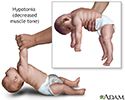Menkes syndrome
Steely hair disease; Menkes kinky hair syndrome; Kinky hair disease
In Menkes syndrome, cells in the body can absorb copper, but they are unable to release it. It is one of several conditions called an " inborn error of metabolism ."
Inborn error of metabolism
Inborn errors of metabolism are rare genetic (inherited) disorders in which the body cannot properly turn food into energy. The disorders are usuall...

Causes
Menkes syndrome is caused by a defect in the ATP7A gene. The defect makes it hard for the body to distribute copper in food from the intestines into the bloodstream for use in other areas. As a result, the brain and other parts of the body do not get enough copper.
Copper can build up in the small intestine and kidneys, but low copper levels in other areas can affect the structure of bone, skin, hair, and blood vessels, and interfere with nerve function.
Menkes syndrome is inherited, which means it runs in families. The gene is on the X-chromosome, so if a mother carries the defective gene, each of her sons has a 50% (1 in 2) chance of developing the disease, and 50% of her daughters will be a carrier of the disease.
Symptoms
Symptoms of Menkes syndrome are:
- Bone spurs
- Brittle, kinky hair
- Feeding difficulties
- Irritability
- Lack of muscle tone, floppiness
-
Low body temperature
Low body temperature
Hypothermia is dangerously low body temperature, below 95°F (35°C).
 ImageRead Article Now Book Mark Article
ImageRead Article Now Book Mark Article - Mental deterioration
- Pudgy, rosy cheeks
-
Seizures
Seizures
A seizure is the physical findings or changes in behavior that occur after an episode of abnormal electrical activity in the brain. The term "seizure...
 ImageRead Article Now Book Mark Article
ImageRead Article Now Book Mark Article - Skeletal changes
Exams and Tests
There is often a history of Menkes syndrome in a male relative.
Signs include:
- Abnormal appearance of the hair under a microscope
- Abnormally low body temperature
- Bleeding in the brain
- Slow growth in the womb
In males, all of the hairs will be abnormal. In females who carry this trait, half of them may have areas of abnormal hair.
Tests may include:
-
Serum ceruloplasmin
(substance that transports copper in the blood)
Serum ceruloplasmin
The ceruloplasmin test measures the level of the copper-containing protein ceruloplasmin in the blood.
Read Article Now Book Mark Article -
Serum copper level
Serum copper level
The ceruloplasmin test measures the level of the copper-containing protein ceruloplasmin in the blood.
Read Article Now Book Mark Article - Skin cell culture
-
X-ray of the skeleton
or
x-ray of the skull
X-ray of the skeleton
A skeletal x-ray is an imaging test used to look at the bones. It is used to detect fractures, tumors, or conditions that cause wearing away (degene...
 ImageRead Article Now Book Mark Article
ImageRead Article Now Book Mark Articlex-ray of the skull
A skull x-ray is a picture of the bones surrounding the brain, including the facial bones, the nose, and the sinuses.
 ImageRead Article Now Book Mark Article
ImageRead Article Now Book Mark Article
Genetic testing may show a change (mutation) in the ATP7A gene.
Treatment
Treatment usually only helps when started very early in the course of the disease. Injections of copper into a vein or under the skin have been used with mixed results.
Outlook (Prognosis)
Most people with this condition die within the first few years of life.
Possible Complications
- Seizures
- Death
When to Contact a Medical Professional
Talk to your health care provider if you have a family history of Menkes syndrome and you plan to have children. A baby with this condition will often show symptoms early in infancy.
Prevention
See a genetic counselor if you want to have children and you have a family history of Menkes syndrome. Maternal relatives (relatives on the mother's side of the family) of a boy with this syndrome should be seen by a geneticist to find out if they are carriers.
References
Bierings M, Clayton P, Houwen RHJ. Disorders in the transport of copper, iron, magnesium, manganese, selenium, and zinc. In: Saudubray J-M, van den Berghe G, Walter JH, eds. Inborn Metabolic Diseases: Diagnosis and Treatment . 5th ed. New York, NY: Springer; 2012:chap 38.
Kaler SG, Packman S. Inherited disorders of human copper metabolism. In: Rimoin D, Korf B, eds. Emery and Rimoin's Principles and Practice of Medical Genetics . 6th ed. Elsevier Ltd: 2013;chap 100.
-
Hypotonia - illustration
Hypotonia is often a sign of abnormality in the case of a newborn or older infant, and may suggest the presence of central nervous system dysfunction, genetic disorders, or muscle disorders. Hypotonic infants rest with their elbows and knees loosely extended, while infants with normal tone tend to have flexed elbows and knees. Head control may be poor or absent in the floppy infant with the head falling to the side, backward or forward.
Hypotonia
illustration
-
Hypotonia - illustration
Hypotonia is often a sign of abnormality in the case of a newborn or older infant, and may suggest the presence of central nervous system dysfunction, genetic disorders, or muscle disorders. Hypotonic infants rest with their elbows and knees loosely extended, while infants with normal tone tend to have flexed elbows and knees. Head control may be poor or absent in the floppy infant with the head falling to the side, backward or forward.
Hypotonia
illustration
Review Date: 4/20/2015
Reviewed By: Chad Haldeman-Englert, MD, FACMG, Wake Forest School of Medicine, Department of Pediatrics, Section on Medical Genetics, Winston-Salem, NC. Review provided by VeriMed Healthcare Network. Also reviewed by David Zieve, MD, MHA, Isla Ogilvie, PhD, and the A.D.A.M. Editorial team.

